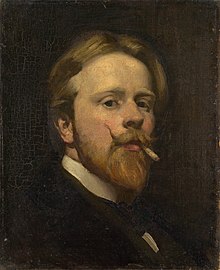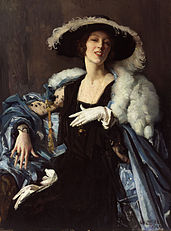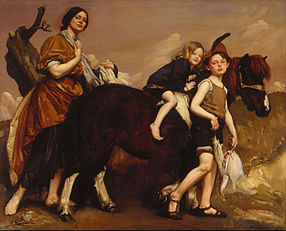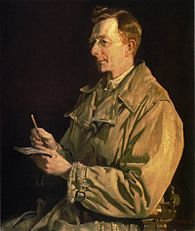George Washington Lambert
George Washington Lambert | |
|---|---|
 George Washington Lambert, c.1925, by Harold Cazneaux | |
| Born | George Washington Lambert 13 September 1873 Saint Petersburg,Russian Empire |
| Died | 29 May 1930(aged 56) |
| Nationality | Australian |
| Education | Julian Ashton Art School |
| Known for | painting,drawing,sculpture |
| Notable work | Across the Black Soil Plains(1899) Anzac, the Landing 1915 (1922) The Squatter's Daughter(1924) Mrs Annie Murdoch(1927) |
| Children | Maurice Lambert,Constant Lambert |
George Washington Thomas LambertARA(13 September 1873 – 29 May 1930) was an Australian artist, known principally forportrait paintingand as awar artistduring theFirst World War.
Early life[edit]
Lambert was born inSt Petersburg,Russia,theposthumous sonof George Washington Lambert (1833 – 25 July 1873, inLondon) ofBaltimore,Maryland.The younger Lambert's mother was Annie Matilda,néeFirth, an Englishwoman. Mother and son soon moved to Württemberg, Germany, to be with Lambert's maternal grandfather. Lambert was educated at Kingston College, Yeovil, Somerset. The family, consisting of Lambert, his mother and three sisters, decided to emigrate to Australia. They arrived inSydneyaboard theBengalon 20 January 1887.[1]
Career[edit]

Lambert began exhibiting his pictures at the Art Society and the Society of Artists, Sydney in 1894. Lambert began contributing pen-and-ink cartoons forThe Bulletinin 1895 and began painting full-time in 1896.[1]Illustrations by Lambert formed part of the bush ballads of theFair girls and gray horses(1898) andHearts of gold(1903) anthologies of Scottish-Australian poetWill H. Ogilvie(1869–1963).
In 1899 he won theWynne PrizewithAcross the Blacksoil Plains.He studied at theJulian Ashton Art SchoolinSydneyuntil 1900. Later, he won a travelling scholarship for 150poundsfrom thegovernment of New South Wales.He spent a year inParisbefore moving toLondonwhere he exhibited at theRoyal Academy.Lambert was awarded a silver medal at an international exhibition for his paintingThe SonnetinBarcelonain 1911. He was most known during this time as a portrait artist.
War artist[edit]

Lambert became an official Australian war artist in 1917 during the First World War.[2]His paintingAnzac,the landing 1915of thelandings on the Gallipoli peninsulain Turkey, is the largest painting at theAustralian War Memorialcollection. Lambert, as an honorary captain, travelled to Gallipoli in 1919 to make sketches for the painting.[1]Another noted work wasA sergeant of the Light Horse(1920), painted in London after his travels in Palestine.[3]
During the war years, George Lambert spent much time in London, where it is suggested he was romantically involved with fellow artistThea Proctor.
Return to Australia[edit]
Lambert returned to Australia in 1921, where he had success inMelbournewith a one-man show atFine Art Societygallery. He was elected an associate of the Royal Academy in 1922. He often visited the homestead of ColonelGranville Ryrieof theAustralian Light HorseatMichelago, New South Walesand there paintedThe Squatter's DaughterandMichelago Landscape.
In the second annualArchibald Prizein 1922, now Australia's most prestigious art prize for portraiture, Lambert's work was disqualified as he had not been a resident in Australia for twelve months.[4]He submitted a self-portrait for the third year, competing withWilliam Macleodwho entered with the subject ofThe Bulletincartoonist'Hop' Hopkins.[5]In 1927 he won theArchibald Prizewith his work titledMrs Murdoch.
In November 1927 he was commissioned to create a statue of writerHenry Lawson;the work depicting Lawson in rough clothes accompanied by a swagman, a dog and a fence post was unveiled inThe Domain, Sydneyon 28 July 1931 by theGovernor of New South Wales,SirPhilip Game.[6]
Personal life[edit]
Lambert married Amelia Beatrice 'Amy' Absell (1872–1963) in 1900. Their children wereMaurice Lambert(1901–1964), a noted sculptor and associate of theRoyal Academy,andConstant,the Britishcomposerandconductor,born inLondonin 1905.Kit Lambert(1935–1981), manager of therockgroupThe Who,was their grandchild.
Lambert died on 29 May 1930 atCobbitty,near Camden, New South Wales, and is buried in the Anglican section ofSouth Head Cemetery.[1]
Some of his family papers from 1874 to 1942 are held in the State Library of New South Wales, Sydney.[7]
His life was dramatised in an episode of the radio seriesFamous Australians.
Gallery[edit]
-
Portrait of the Artist's Family
-
Holiday in Essex
-
Portrait of a Lady
-
The Holiday Group (The Bathers)
-
Sybil Waller in a Red and Gold Dress
-
Miss Thea Proctor
-
The artist's wife, Amy, and their sonConstant
See also[edit]
Notes[edit]
- ^abcdMartin Terry (1983)."Lambert, George Washington (1873–1930)".Lambert, George Washington Thomas (1873 - 1930).Australian Dictionary of Biography,Volume 9.MUP.pp. 649–650.Retrieved15 July2009.
- ^'Camofleur',"Musketeers of Brush and Pencil with the A.I.F.: Art Under Fire: The Battlefield as Studio",The (Melbourne) Herald,(1 February 1919), p. 4.
- ^"A sergeant of the Light Horse".George W Lambert Retrospective.National Gallery of Australia.Retrieved4 May2013.
- ^"Archibald Prize".The Daily Telegraph.No. 13, 621. New South Wales, Australia. 6 January 1923. p. 5.Retrieved24 February2019– via National Library of Australia.
- ^"Gossip".Smith's Weekly.Vol. IV, no. 46. New South Wales, Australia. 6 January 1923. p. 17.Retrieved24 February2019– via National Library of Australia.
- ^"George W. Lambert retrospective".National Gallery of Australia.Archived fromthe originalon 2 February 2017.Retrieved12 February2014.
- ^"George Lambert and Lambert family, papers and pictorial material, ca. 1874-1942".Catalogue.State Library of New South Wales.Retrieved19 May2020.
References[edit]
- Serle, Percival(1949)."Lambert, George Washington".Dictionary of Australian Biography.Sydney:Angus & Robertson.Retrieved15 July2009.
Further reading[edit]
- Grey, Anne (1996).George Lambert, 1873-1930: art and artifice.Roseville East: Craftsman House.ISBN9057040514.
- Grey, Anne (1996).George Lambert (1873-1930) catalogue raisonne: paintings and sculpture, drawings in public collection.Perth: Bonaray Press in association with Sotheby's and the Australian War Memorial.ISBN0646301217.
External links[edit]
- 5 artworks by or after George Washington Lambertat theArt UKsite
- Artist profile - Australian War Memorial
- Lambert exhibition, Gallipoli and Palestine landscapes - Australian War Memorial
- George Washington Lambert at Australian Art
- George Washington LambertatFind a Grave
- Profile on Royal Academy of Arts Collections
- 1873 births
- 1930 deaths
- Emigrants from the Russian Empire to Australia
- Australian war artists
- World War I artists
- Archibald Prize winners
- Archibald Prize finalists
- Australian portrait painters
- Lambert family
- Russian portrait painters
- British war artists
- Paintings by George Washington Lambert
- Wynne Prize winners
- 20th-century Australian painters
- 20th-century Australian male artists
- Symbolist painters
- Associates of the Royal Academy
- Julian Ashton Art School alumni
- Australian male painters
- Australian people of German descent
- Australian people of American descent

















